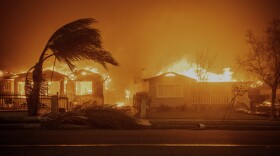This is a developing story. For the latest local updates, head to LAist.com. Also, sign up for NPR's breaking news alerts.
Air tankers are dropping thousands of gallons of red flame retardant in the hills around Los Angeles as firefighters attempt to limit the devastation from multiple wildfires.
Images of vivid red clouds enveloping trees and scrubland prompt two questions: What is it, and what's in it?
"It's primarily a product called Phos-Chek LC95, which is sold by a company called Perimeter," Daniel McCurry, an associate professor in civil and environmental engineering at the University of Southern California, tells NPR.
"It's been used for decades by the Forest Service," he says. "It's one of maybe only two products currently approved for aerial use by the Forest Service."
Air tankers and chemical fire retardants have been used since the 1950s, allowing firefighters to reach difficult spots. The U.S. Forest Service says retardants are used to "slow the rate of spread by cooling and coating fuels, depleting the fire of oxygen, and slowing the rate of fuel combustion as the retardant's inorganic salts change how fuels burn."
So, what's in it?
"It's basically a mixture of water, fertilizer, and then the red color that you see is just rust," McCurry says. In the wild, the color fades over time with exposure to sunlight.
"You might see a gum or thickening agent just to change the viscosity, how sticky this stuff is," McCurry says. Thickeners also keep the material from drifting off-target, he adds, "But the business end of it really is ammonium phosphate fertilizer."
For anyone who's heard of fertilizer being used in explosives: That's ammonium nitrate. Phos-Chek commonly contains two types of salt: diammonium phosphate ([NH4]2HPO4) and ammonium polyphosphate ((NH4PO3)n).
Along with its use as a fertilizer (providing nitrogen and phosphorous to plants), you often see ammonium phosphate in crystal-making kits that are popular with children.
So, how does it stop fires from spreading?
Under normal conditions, cellulose in plant matter decomposes as it's heated, producing flammable compounds. Phos-Chek's maker says the reaction between the retardant and cellulose consumes heat energy from the approaching fire and produces non-flammable carbon material.
The goal is to slow or stop the fire's spread, especially if the area includes homes or other structures.
"They don't tend to drop [retardant] directly in the center of an ongoing fire," McCurry says. "They tend to drop kind of at the barrier of it because they're trying to prevent it from spreading. And the reason that these products are kind of useful for that potentially is that the active ingredient is not water. Right? It's the fertilizer. So even after the water evaporates, you still have that red stripe there for days or weeks."

Big air tankers can drop up to 9,400 gallons of Phos-Chek onto trees and other potential fuels. The massive quantities have spurred McCurry and other researchers to consider potential harms from the material. But McCurry says people in a fire zone likely have more pressing worries.
"In terms of immediate concern, the main thing I'd be worried about, regardless of whether there's fire retardant used or not, is just air pollution — like particulate matter," he says. "If you're walking around in an area that's been burned, it's probably still very smoky. So it'd be a good idea to wear a respirator."
Is it safe?
Due to environmental concerns, the Forest Service has a mandatory ban on aerial retardant drops in sensitive areas such as waterways and endangered species habitats (map). That ban is in effect "except when human life or public safety are threatened." Using retardants in restricted areas must be reported for possible remediation.
Phos-Chek doesn't include any substances flagged by California's Proposition 65 list of materials that are known to cause cancer and other harms, according to its maker.
The Forest Service's specifications for wildfire retardants ban PFAS, known as "forever chemicals," along with other unacceptable compounds.
Last year, McCurry and his colleagues published a study suggesting some fire suppression products, including Phos-Chek, can contain toxic heavy metals such as cadmium and chromium. The Forest Service says heavy metals aren't added to fire retardants, "But may be present as naturally occurring impurities in the retarding salts (which come from the same source as crop fertilizers)," Boise State Public Radio reported last November.
As for the air tankers' operations over smoldering hillsides, the most immediate danger would seem to be to the aviators.
"It's a really heroic job," McCurry says of the pilots — many of them former military, he says — who guide massive planes through low-altitude drops over challenging terrain. "You know, some of those guys die every year."
Between 2000-2013, there were 78 aviation deaths related to fighting wildfires, according to a 2015 report by the Centers for Disease Control and Prevention.
The California Newsroom is following the extreme weather from across the region. Click through to LAist's coverage for the latest.
Copyright 2025 NPR






